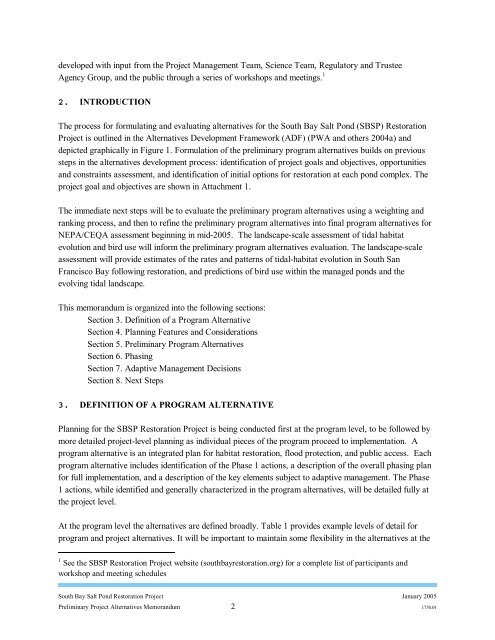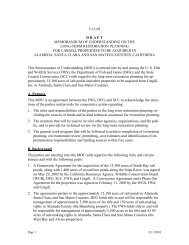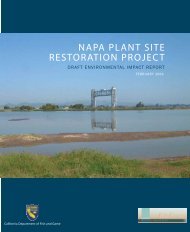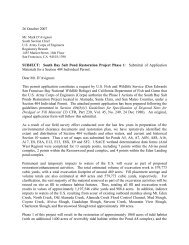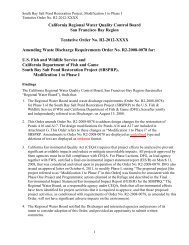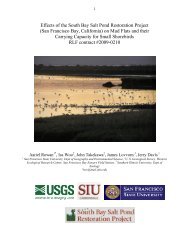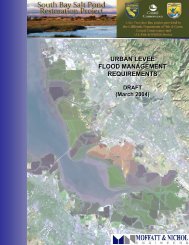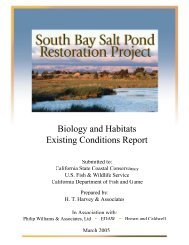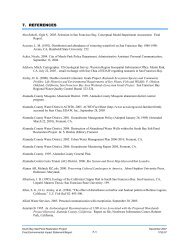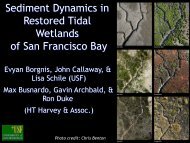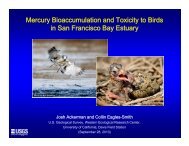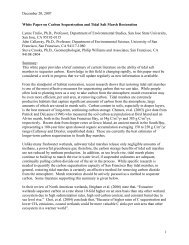M E M O R A N D U M - South Bay Salt Pond Restoration Project
M E M O R A N D U M - South Bay Salt Pond Restoration Project
M E M O R A N D U M - South Bay Salt Pond Restoration Project
You also want an ePaper? Increase the reach of your titles
YUMPU automatically turns print PDFs into web optimized ePapers that Google loves.
developed with input from the <strong>Project</strong> Management Team, Science Team, Regulatory and Trustee<br />
Agency Group, and the public through a series of workshops and meetings. 1<br />
2. INTRODUCTION<br />
The process for formulating and evaluating alternatives for the <strong>South</strong> <strong>Bay</strong> <strong>Salt</strong> <strong>Pond</strong> (SBSP) <strong>Restoration</strong><br />
<strong>Project</strong> is outlined in the Alternatives Development Framework (ADF) (PWA and others 2004a) and<br />
depicted graphically in Figure 1. Formulation of the preliminary program alternatives builds on previous<br />
steps in the alternatives development process: identification of project goals and objectives, opportunities<br />
and constraints assessment, and identification of initial options for restoration at each pond complex. The<br />
project goal and objectives are shown in Attachment 1.<br />
The immediate next steps will be to evaluate the preliminary program alternatives using a weighting and<br />
ranking process, and then to refine the preliminary program alternatives into final program alternatives for<br />
NEPA/CEQA assessment beginning in mid-2005. The landscape-scale assessment of tidal habitat<br />
evolution and bird use will inform the preliminary program alternatives evaluation. The landscape-scale<br />
assessment will provide estimates of the rates and patterns of tidal-habitat evolution in <strong>South</strong> San<br />
Francisco <strong>Bay</strong> following restoration, and predictions of bird use within the managed ponds and the<br />
evolving tidal landscape.<br />
This memorandum is organized into the following sections:<br />
Section 3. Definition of a Program Alternative<br />
Section 4. Planning Features and Considerations<br />
Section 5. Preliminary Program Alternatives<br />
Section 6. Phasing<br />
Section 7. Adaptive Management Decisions<br />
Section 8. Next Steps<br />
3. DEFINITION OF A PROGRAM ALTERNATIVE<br />
Planning for the SBSP <strong>Restoration</strong> <strong>Project</strong> is being conducted first at the program level, to be followed by<br />
more detailed project-level planning as individual pieces of the program proceed to implementation. A<br />
program alternative is an integrated plan for habitat restoration, flood protection, and public access. Each<br />
program alternative includes identification of the Phase 1 actions, a description of the overall phasing plan<br />
for full implementation, and a description of the key elements subject to adaptive management. The Phase<br />
1 actions, while identified and generally characterized in the program alternatives, will be detailed fully at<br />
the project level.<br />
At the program level the alternatives are defined broadly. Table 1 provides example levels of detail for<br />
program and project alternatives. It will be important to maintain some flexibility in the alternatives at the<br />
1 See the SBSP <strong>Restoration</strong> <strong>Project</strong> website (southbayrestoration.org) for a complete list of participants and<br />
workshop and meeting schedules<br />
<strong>South</strong> <strong>Bay</strong> <strong>Salt</strong> <strong>Pond</strong> <strong>Restoration</strong> <strong>Project</strong> January 2005<br />
Preliminary <strong>Project</strong> Alternatives Memorandum 2 1750.01


